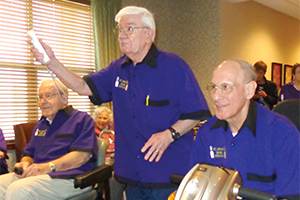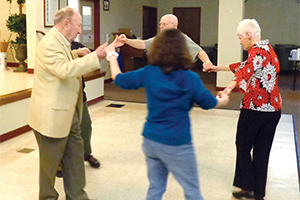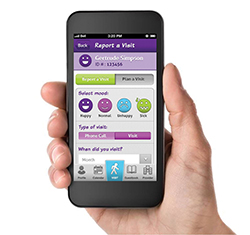By JULIE MINDA
At St. Leonard in Centerville, Ohio, residents, staff and community members can join clubs and classes for walking, reading, playing cards, creating art, biking, learning martial arts, discussing national issues, dancing, swimming or studying the Bible.
Richard Beach is a St. Leonard resident who said he feels invigorated by the level of social activity at the facility. He is in the political issues discussion club; and he and his wife take an on-campus yoga class. "It keeps you alive — you can come here and wait for the Lord to come, or you can keep living. We came here at age 81 and feel younger than our age now. We love to be involved."

Wes Rogers, a resident of St. Leonard in Centerville, Ohio, practices for a Wii bowling tournament against neighboring retirement communities as residents Ray Mock, at left, and Bill Feldmann
look on.
St. Leonard's wellness director, Jack Harless, said the continuing care retirement community has been able to involve the majority of residents — more than 60 percent of them — in healthful activities that keep them functioning well by ensuring the activities are social and sustain people's interest.
Roll out the barrel
"It's one thing to get people moving, it's another thing to keep people moving; and we have found that when people do activities in a social environment, there is better long-term compliance," said Harless. "Our activities revolve around what people like — like with our chair polka class, the music is popular and the residents really like being together in the class."
St. Leonard has been taking an intentional approach to improving residents' health and wellness through socially stimulating activities since 2010, when it adopted Vital Life. Developed by a consultant, the program aims to delay the onset of frailty and contribute to an improved quality of life for residents in the St. Leonard community. Offerings are open to staff and community members too.
St. Leonard Executive Director Tim Dressman said Vital Life is based on a social model of wellness that holds that when people participate together in wellness activities, "we perform better. And we need accountability — when we all do the activities together, we're accountable (to each other). Often when we try to accomplish (wellness goals) by ourselves, we fail." He said when people try to achieve their goals together with friends, they may be more motivated to succeed.
Free advice
St. Leonard has more than 800 residents living in its independent housing, assisted living, long-term care, memory care and short-term rehabilitation units. Like many eldercare campuses, St. Leonard has long offered various types of activities, according to Dressman. But it wasn't until implementing Vital Life that St. Leonard began seeking the input of residents and staff in shaping the type of activities it would offer with the intent of improving mental and physical functioning and well-being.
Bill Witte founded Vital Life and has been its chief executive since he retired in 2002 as the top executive of an Atlanta-based architecture firm that designs senior living facilities, among other specializations. Witte now consults with eldercare facilities, offers the Vital Life program and hosts an online learning community called Vital Nation — all pro bono and all aimed at helping not-for-profit long-term care facilities to redesign their programming and environment to keep residents active and healthy.
Witte's premise is that the vast majority of seniors are financially unprepared for the medical costs that may hit them in old age, particularly if they develop debilitating chronic conditions. He believes that if senior adults nurture eight dimensions of wellness, they can vastly improve their health and functioning, live longer before becoming frail, reduce their health care costs and make their life savings last longer. The eight dimensions are: physical, social, nutritional, intellectual, environmental, spiritual, occupational and emotional wellness.
The Vital Life programming includes activities connected with all eight dimensions.
Shared philosophy
According to Witte, St. Leonard is the only facility that has fully implemented Vital Life, although other U.S. eldercare facilities have consulted with Witte and implemented certain aspects of Vital Life.

St. Leonard residents take part in a dance class in the facility's auditorium offered as part of the Vital Life program.
Dressman became interested in Vital Life after attending a gathering of eldercare facility heads convened by Witte. Dressman said when Witte shared his concept for eldercare and his vision for implementing Vital Life, Dressman recognized in Witte a shared philosophy. Dressman and St. Leonard leaders had been concerned about the unsustainability of the system in which residents in declining health quickly exhausted their limited funds. The leaders believed that through a preventive approach like Witte's, St. Leonard could help residents stay healthy longer, and stretch their financial resources.
St. Leonard worked with residents and staff to set up the classes, groups and activities. Most offerings are open to residents, staff and community members; but some are offered just to residents, or on rarer occasion, just to staff. Each activity generally attracts between 10 to 20 participants. Most of the activities are free to the residents. St. Leonard helps pay for the usually modest costs of program overhead or helps secure mini-grants from other organizations.
Many of the activities are offered through St. Leonard's on-site wellness center, which has a lap pool, therapy pool, fitness room, meditation room, garden, day spa, restaurant and multipurpose rooms. That center has proven popular for residents, staff and community members — about 90 percent of the members of the wellness center are not residents of St. Leonard.
There are Vital Life activities offered for people across the continuum, including in the skilled nursing and dementia units. Dressman said St. Leonard offers accommodations so that people with disabilities and dementia can participate. For instance, staff assist dementia patients so that they can take part in the art classes.
Promising results
Dressman said that while organizers survey participants on their engagement in the programming, St. Leonard does not have data to demonstrate whether the Vital Life activities measurably improve the health and wellness of residents, improve their functioning and delay decline. (St. Leonard is considering conducting some type of analysis of Vital Life's impact in the future.)
However, Dressman said that in the surveys, Vital Life participants positively rate their health in the eight dimensions of wellness. Residents tell leaders and staff they feel increasingly engaged and healthy as they take part in the activities.
| CareMonster app keeps families in the loop on loved one's health, visitors
 The CareMonster app cues users to share quick updates on a frail loved one's mood and health. Now, there's an app with the potential to provide clearer communication among family and supportive friends through one central information repository — CareMonster. St. Leonard, a continuum of care senior community in Centerville, Ohio, is among 30 customers using the app; these include home health care businesses, long-term care facilities and hospice providers in Ohio and Indiana and a handful of other states. Michael Eidsaune, who co-developed the app with his father-in-law, said the impetus grew out of frustration that he and his family members felt when they were trying to coordinate among themselves the care of Eidsaune's great grandmother. The app is called CareMonster because it aims to keep the responsibility for caring for another from being scary or intimidating for families, he said. Dayton, Ohio-based CareMonster sells client facilities, such as St. Leonard, a provider number for the app that allows the buyer to share the app with anyone they want to, providing both a tool for the provision of care, and a way to circulate their name and brand throughout their communities, Eidsaune said. Purchasers can brand the app screen with their facility's name. St. Leonard provides the access number at no cost to a family member or friend willing to set up the care communication network by inviting others into their group. St. Leonard offers the app at no cost to families with loved ones living at its continuum-of-care campus and to others in the region, including those whose supportive efforts help frail seniors live at home. When a member of a support network visits his or her loved one, the visitor can tap an emoticon on the app to report back to the group that their host is feeling "happy, normal, unhappy or sick" or they can write a message. Participants retrieve the updates on their smartphones, tablets or computers. A guest book feature on the app allows people to record when they plan or make a visit; group members can fill gaps in the visiting schedule. They use a checklist to indicate if they brought groceries or helped with another errand or task. The person whose well-being is the subject of the app can be included in the network group, and add information about visitors or needs. Casey Howard, St. Leonard's director of marketing, said St. Leonard started offering the CareMonster app last year. "We just really liked the idea of opening up communication, and we thought it was a great tool for families to communicate." — Betsy Taylor |
| Research supports Vital Life premise
The Vital Life program is built upon the idea that senior adults' functioning will improve — and they can delay declining health — if they nurture eight areas of their wellness, which include physical, spiritual, emotional and social health. Various studies indicate that the Vital Life premise has validity. For instance: - According to research reported by Alzheimer's Family Services in 2009, "people with regular social ties are significantly less likely to demonstrate cognitive decline" than people who are isolated.
- The American Psychological Association's Monitor on Psychology in 2011 published an interview with a psychologist who coauthored a study on longevity. That researcher, psychologist Howard Friedman, concluded from his studies that "connecting with and helping others" is a key factor promoting a long, healthy life.
- A report on "Healthy Aging: Lessons from the Baltimore Longitudinal Study of Aging" found that "exercise and physical activity are considered a cornerstone to almost every healthy aging program. Emerging scientific evidence suggests that people who exercise regularly not only live longer, they live better. And, being physically active … can help you to continue to do things you enjoy and stay independent as you age. Specifically, regular exercise and physical activity can reduce your risk of developing some disease and disabilities that often occur with age."
- A 2012 report in the publication Maturitas said that "exercise can partially reverse the effects of the aging process on physiological functions and preserve functional reserve in the elderly. Numerous studies have shown that maintaining a minimum quantity and quality of exercise decreases the risk of death, prevents the development of certain cancers, lowers the risk of osteoporosis and increases longevity."
|
Copyright © 2014 by the Catholic Health Association
of the United States
For reprint permission, contact Betty Crosby or call (314) 253-3477.